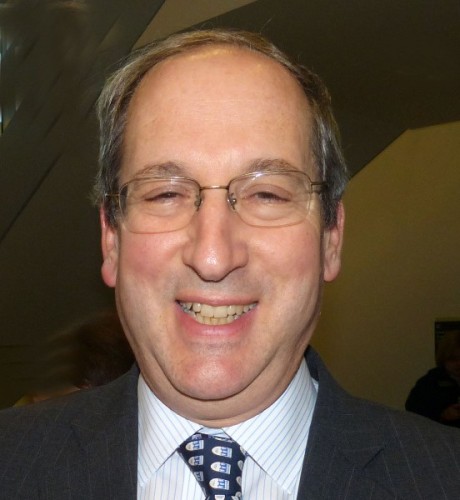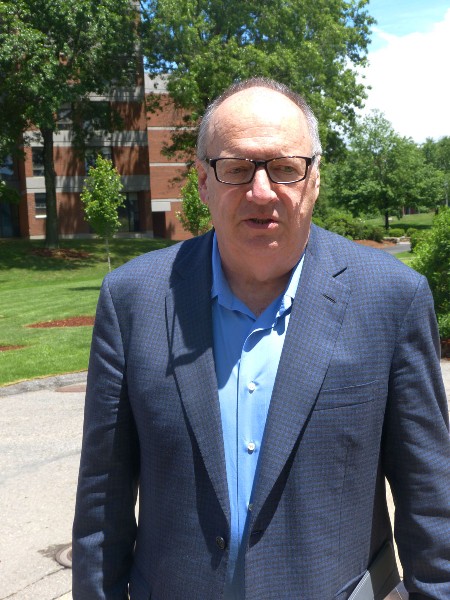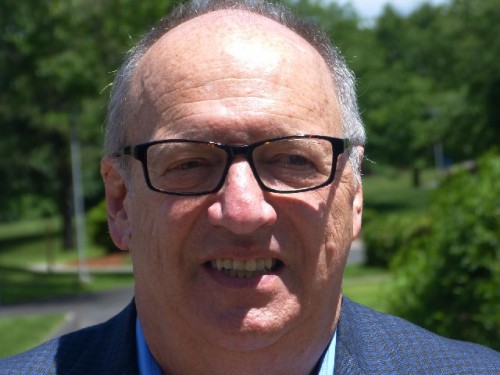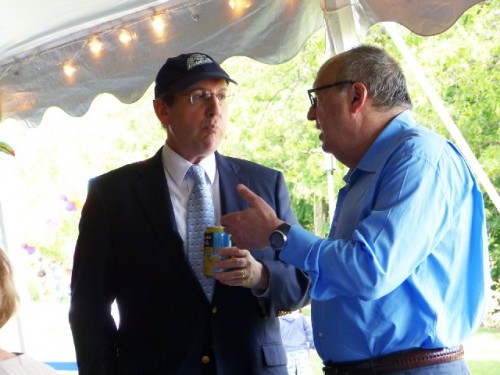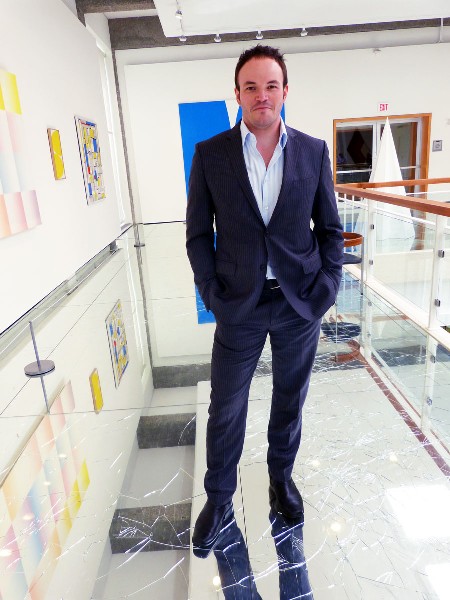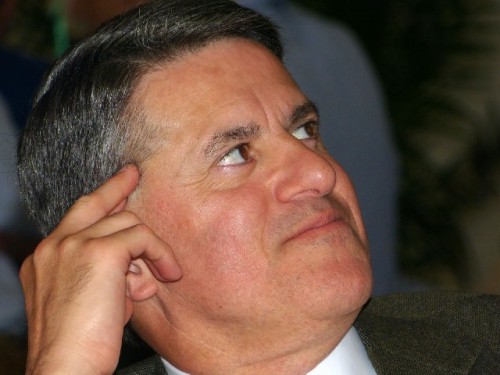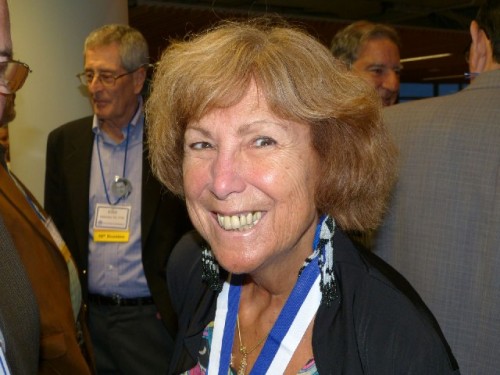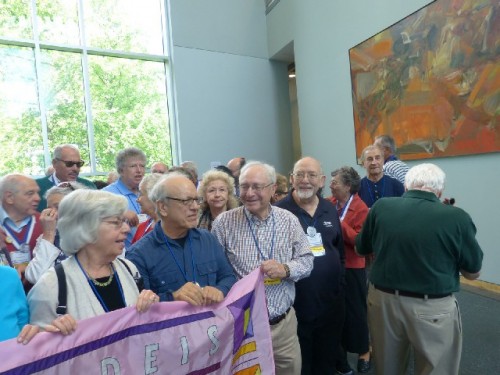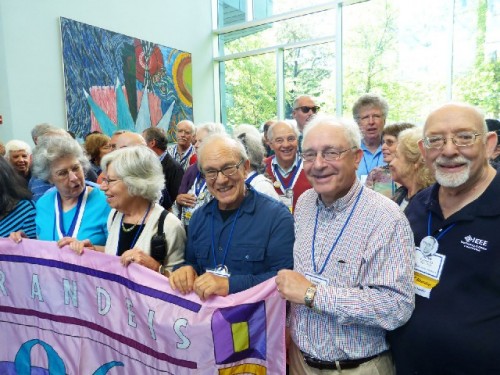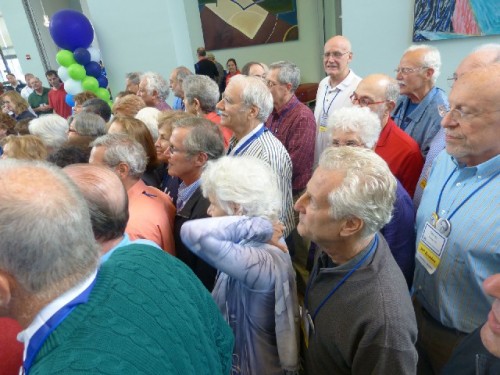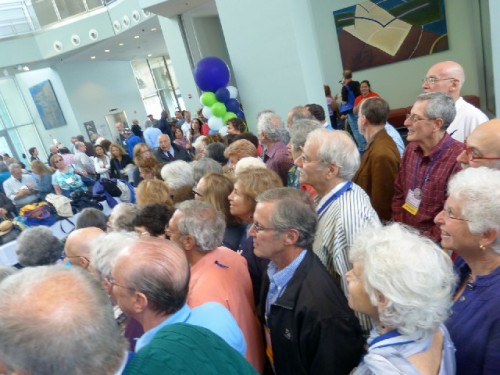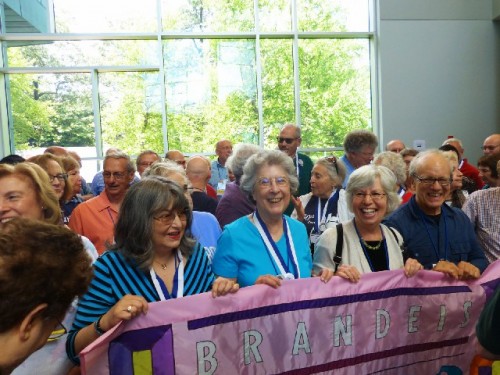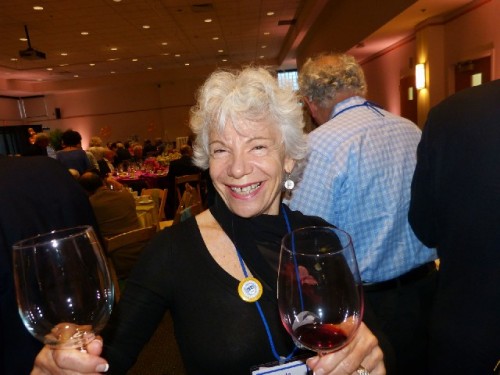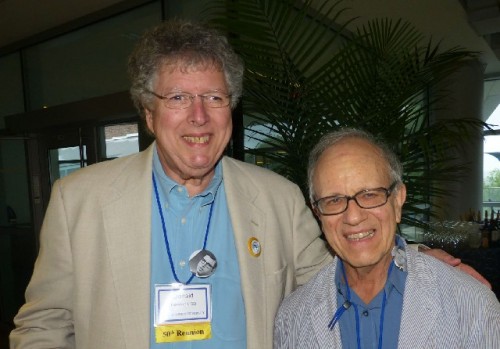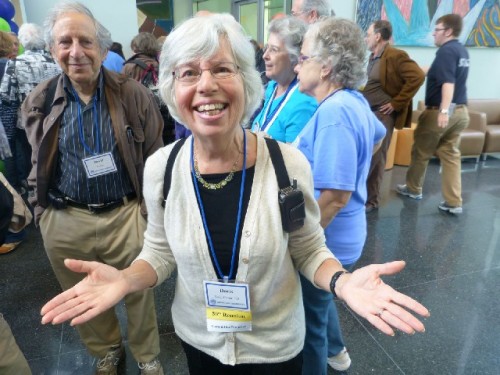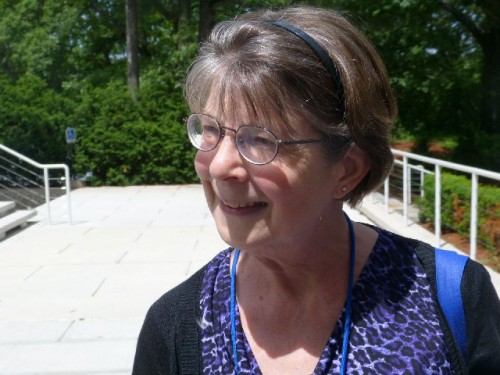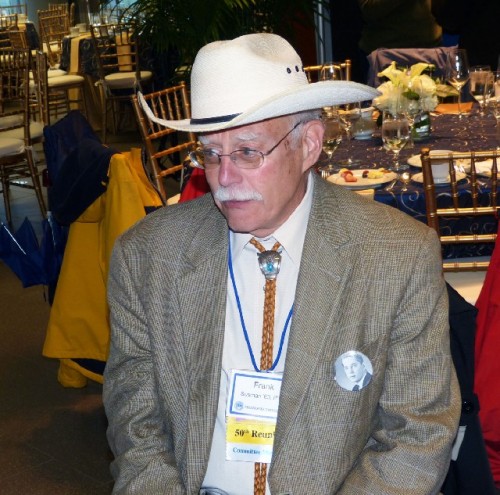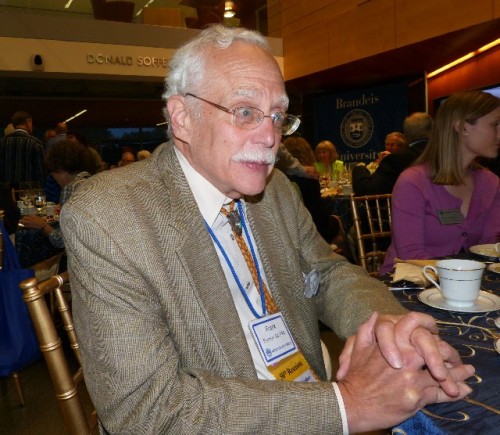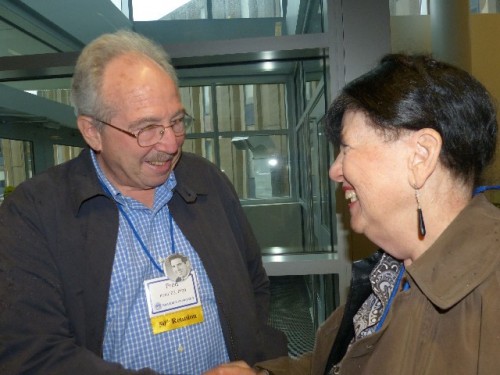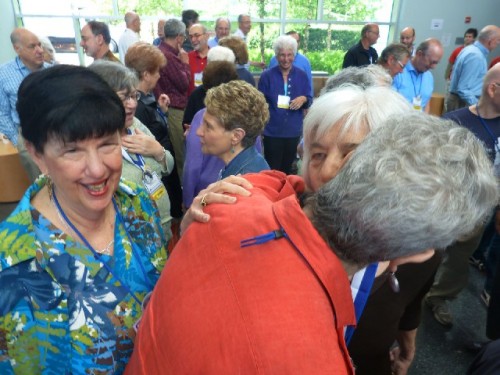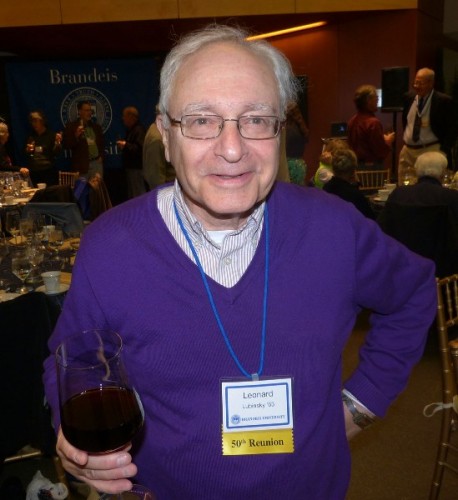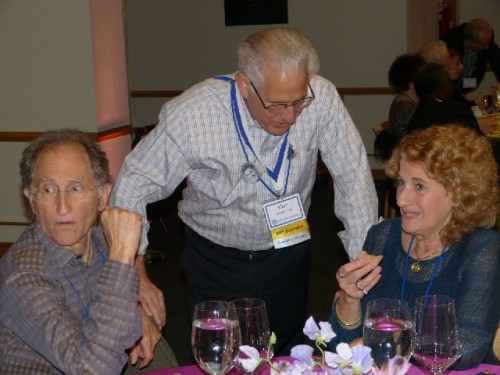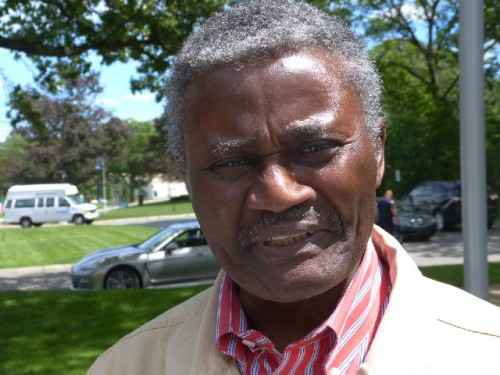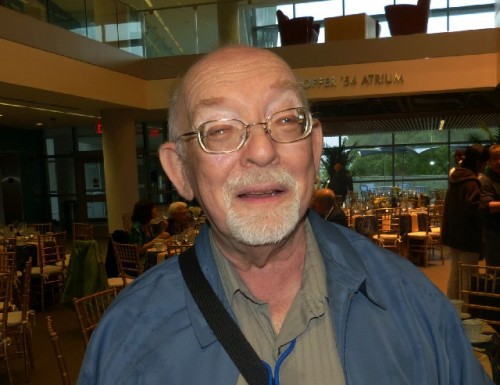Brandeis 50th Reunion
Recalling the Radical Class of 1963
By: Charles Giuliano - Jun 11, 2013
The Bernard Madoff scandal, which broke in December, 2008 had a particularly devastating impact on his primarily Jewish clients and their philanthropies. That occurred hard on the heels of the financial meltdown which saw most stock portfolios reduced by half.
In January, 2009 Jehuda Reinharz, then President of cash strapped Brandeis University, announced a decision to close the Rose Art Museum, and sell off its renowned contemporary collection. Largely through the vision of its prescient founder, Sam Hunter, the value of the museum’s holdings was set at some $350 million.
There was a crushing fire storm of media protest. It was deemed untenable and against all standards for museums to view its works, held in trust for future generations, as an expandable liquid asset. To sell even a fraction of the key and most valuable works, for a quick fix of desperately needed cash, meant that the Rose could no longer function as a museum. It was an all or nothing proposal.
The response of the Brandeis community, students, faculty, alumni and parents was at best mixed. Assuming that many of those in favor of selling the collection had never set foot in the museum, regarded in the field as the Mecca for contemporary art in New England, they had little or no interest in preserving a rare and fragile legacy.
The subsequent law suits by trustees and donors through ongoing media coverage badly, if not permanently, damaged the reputation of Brandeis as a progressive, radical, secular institution.
From its beginning in 1948, on the Waltham campus of the former Middlesex College of Medicine and Surgery, founded by John Hall Smith, Brandeis had an identity crisis. It was established as a non sectarian university, named for a Supreme Court Justice, with a legacy of response to the aftermath of the Holocaust with resistance to the black listing of McCarthyism. It attracted primarily secular and reformed Jews with a minority of orthodox Jews. Non Jews were welcome and there was a progressive program of Wien scholarships recruiting international students. This complex mix of elements resulted in factions ranging from radical/ revolutionary through socially, politically and religiously traditional and conservative.
It was often observed that an “articulate” minority of students, radicalized by the most remarkable faculty of any university of its era, induced at times unwelcome headlines on the front lines of dissent, political and social protest. This activism often soured Jewish philanthropy which turned to Israel as a greater priority. The rapidly expanding campus and its infrastructure, a lack of deep pockets and generations of building endowment, made the institution debt strapped and vulnerable.
Hard times called for tough decisions. It cost Reinharz his Presidency and he resigned on September 25, 2009 with the future of the Rose still unresolved. He stayed on during the search for a new President and now is Richard Koret Professor of Modern Jewish History and Director of the Tauber Institute for the Study of European Jewry.
Frederick M. Lawrence took office as the eighth president of Brandeis University on Jan. 1, 2011. An accomplished scholar, teacher and attorney, Lawrence is one of the nation’s leading experts on civil rights, free expression and bias crimes. As a part of his mandate Lawrence promised not only to settle the lawsuits but to revitalize the Rose. To that end Christopher Bedford, 35, the Scottish born, former chief curator at the Wexner Center for the Arts in Columbus, Ohio took over as director last September. The museum had been without leadership since the departure of Michael Rush in June, 2009.
During the Rose controversy we posted extensive coverage including a multi installment interview with former director Carl Belz. He was replaced by Joe Ketner under whose watch the museum built its Lois Foster Wing designed by Graham Gund. In an article I stated that I would never again set foot on the Brandeis campus. I covered the Rose extensively through the years. As president of the campus art club, I was an undergraduate speaker during the dedication of the museum.
Fortunately, the Rose mess was resolved in time to participate in my 50th Reunion and gathering of the Class of 1963 this past weekend.
It was with a range of mixed emotions on my end that Astrid and I registered during a rainy Saturday morning. I had been nudged into participating by a classmate Susan Smullin Jones.
Typically, we were soon immersed in academic discourse with a number of options for sessions. The lecture and interaction with Professor Dawn Skorczewski discussing the research for her book “The Accident of Hope: The Therapy of Anne Sexton” evoked flashbacks to those incredible classroom encounters of my undergraduate years.
We lasted briefly in an aerobics class and decamped for the emotional roller coaster of a lecture on the pros and cons of Jewish assimilation. It again raised the specter of a complex Brandeis identity and heritage evoking a fascinating range of responses from the audience. Commenting on the tone and drift of the presenter one man stated “For me being a good Jew does not mean that I have to be a Zionist.” Another asked “When did assimilation become a dirty word?” There was speculation about how Jewish assimilation was different from that for the Irish, Italians, or Greeks? There were recollections to having those discussions formally and informally fifty years ago.
As a gentile at Brandeis I wondered about how I had perhaps been “assimilated” by the Judaism of Brandeis? The answer is likely yes and positive. Surely not for Zionism but certainly through its Jewish tradition of dissent and the primacy of intellect, philosophy, politics, psychology and the arts as signifiers of identity.
All of which were touched on profoundly and with warm humor by Jon Landau, the noted rock critic and entrepreneur, in a speech accepting an Achievement award from President Lawrence.
I knew Jon from Boston/ Cambridge media days when in 1974 he famously wrote in The Real Paper "I saw rock and roll future and its name is Bruce Springsteen."
Actually, he wrote the first book about Brandeis from the perspective of a graduate (Class of 1968). He recalled playing in the dorms with his band The Lollipops. He discussed cutting his teeth as a rock critic in the school’s newspaper The Justice. One of his first such efforts was a slice and dice of Cream. Later, as a nominator and juror, he was on hand when the band reunited to rehearse and perform during its induction into the Rock ‘n’ Roll Hall of Fame. With humor he admitted having made a mistake.
Back then Brandeis had many required courses including science and languages. Landau commented on his struggles including flunking first Spanish and then French before managing to pass a course in French lit “Taught in English” to earn a degree.
He spoke of being inspired by a remarkable faculty including a course with the legendary visionary and guru, art historian, Leo Bronstein. It inspired him when he had the means to collect art. Catching up with him I asked if he collected contemporary art? No, Italian Renaissance, was the answer. I asked if that included any artists I might be familiar with? “Have you heard of Botticelli, Donatello and Titian?” was the response.
Like Landau I recall a remarkable faculty and spectacular range of guest speakers from James Baldwin, to Gus Hall, or Martin Luther King, Jr. During a lecture on Zen Buddhism Alan Watts threw a piece of chalk at me. On Sunday afternoons I attended the PBS programming of Eleanor Roosevelt and frequent guest Max Lerner. On one of those Sunday mornings she visited the cafeteria with Adlai Stevenson and Marc Chagall. Hans Hofmann asked if I was a painter or a sculptor? Jacques Lipchitz told me the African Art I helped to curate in the library “Are all fakes.” Years later, Rose director Bill Seitz invited me to lunch with his former protégée Frank Stella. I spoke with Helen Frankenthaler while she installed her work in the Rose. We heard Pete Seeger perform during Freshman orientation. Joan Baez sang in a lounge in North Quad. For $18 she rode in from Cambridge on the back of a Vespa. We used to make trips to Cambridge to hear her at Club 47 with her boyfriend Bob.
There were all those famous professors like Herbert Marcuse, Abraham Maslow, Philip Rahv, Paul Radin, Arnold Hauser, Leonard Bernstein, and Irving Howe to name but a few. I heard them lecture but regret not taking courses with them. One of my most memorable experiences was a semester of Greek classics with Irving’s Greek wife, Thalia Howe. It still informs my approach to fine arts and theatre.
During a general session meeting with President Lawrence, with what was left of his fading vocal chords, he fielded questions.
To paraphrase I asked.
In September of 1959 when we arrived on campus Brandeis was then just eleven years old. For many of us that represented considerable risk taking. We soon found that we were in a haven for dissent. Many of the faculty members came to Brandeis because of the Holocaust and the black listings of McCarthyism. A radical faculty resulted in a radicalized student body impacting all of us in our own separate fields and careers. Many Brandeis students were Red Diaper babies. The Rose Art Museum was a part of that legacy and was at the time of its founding the most radical university museum in America. We are grateful to you for saving the Rose.
My question is how does Brandeis preserve and maintain that radical legacy? Which Jon Landau referred to so eloquently. Is Brandeis today still a radical university or has it become a Jewish version of Tufts University?
There were gasps from the audience but I am hardly the first to have raised that question. During our time both faculty and the activist student body were on a par with, and more progressive than, any major university in America. Today I doubt that holds true. In academic surveys and rankings my assessment is not far off the mark.
Recovering adroitly Lawrence humorously deflected the zinger by focusing on how much he respects his peers at Tufts. He acknowledged that the question was a reality check and “Now it gets real” adding that on any “given day Tufts aspires to be Brandeis.” While acknowledging the unique circumstances that surrounded the founding and early years of Brandeis he hopes that we never again have to live through them.
But, come on now, in a sense aren’t we? No, we are not enduring another round of McCarthyism but what the heck happened to dissent in America? The Children’s Crusade of Occupy Wall Street didn’t figure out how to last through winter. While more and more the Obama administration’s policies, bolstered by Homeland Security and The Patriot Act, are no different than under Bush and Cheney. We expected a different administration from our first African American President.
While the middle class has disappeared the term liberal is now a dirty word. America has swung to the political and religious right. As we sensed during the session on assimilation Christian fundamentalism is not that different from its Jewish incarnations. So just what is the institutional identity of Brandeis? The response of President Lawrence was articulate and charming but not terribly compelling.
Between sessions we took a drive around campus finding a dense configuration of new buildings. We explored The Castle where my mother studied medicine. I pointed out the arch above the entrance, and its now sealed off room, where I painted a secret mural inspired by The Iliad. I took Bronstein to see it. I used to show slides for his classes and drove him back to Cambridge. There were remarkable conversations. Like stalking my art history professor, Creighton Eddy Gilbert, at his favorite Waltham bar where he was known as Eddy. That’s Eddy as in Mary Baker Eddy. Creighton was the most brilliant art historian and mentor of my entire life.
Like many professors of that era Creighton ended up teaching Renaissance art at Brandeis because of a scandal. After some rehab at Brandeis he moved on to Yale where he belonged. Marcuse and Maslow left to become academic stars. Angela Davis followed Marcuse to Berkeley and the rest is history.
Over lunch I asked classmate Evan Stark how well he had known Angela who was behind us. He recalled that she only became radical later. But he kept in touch with Abby Hofmann and was at one point roommates with Gerry Rubin. I hope to talk further and post a dialogue with Stark who was kicked out of eight graduate programs for his political activities.
There is some masochism in attending a Brandeis reunion. It is humbling to interact with such brilliant and successful classmates. During dinner conversation Frank Susman from Santa Fe discussed arguing two separate Supreme Court cases during the same day. Following a PhD in Philosophy from Harvard Roger Wertheimer was bored with academics and served for a time as a Deputy Sheriff in Oregon. Dr. Oluwatope Mabogunje, a Wien Fellow, described practicing medicine and teaching in Nigeria. Ed Perlmutter shared memories of our days as classmates at Boston Latin School.
Looking through the reunion book my most interesting classmates didn’t attend. Many friends were from classes ahead or behind us or graduate students. The artist Benno Friedman, from the Berkshires, for example, played an enormous role in my life as well as those of many others. I really miss Bob Markowitz one of the coolest dudes you would ever want to know. The legendary and mysterious Russell Klavun. Where was the artist/ architect Eric Pfeufer? The total gonzo Rachel Goldstein from Georgia and her friend the Mexican Roberto Figueroa? Or the wonderful alto sax player, Lennie Popkin, who hooked me on his teacher Lennie Tristano. A bunch of us made pilgrimages to New York when Tristano played at the Half Note. Popkin has yet to return my Stan Kenton LPs which he borrowed. Later I was close to Stan.
While successful overall, with a high percentage of PhDs and distinguished careers, it seems that we didn’t make a ton of money. That just wasn’t a priority. Vic Samuels, the class president and a businessman from Texas, reported that the class raised $1.2 million. Some 46% of the class donated and he would like to get it up to 60%. Of the 310 that marched during commencement some 45 are now deceased. Including my best friend, Fernando Alonso, who Evan recalled fondly. Claire Bradley, a graduate of Waltham High, died young.
There were many warm remarks and colorful memories. A woman, in the presence of Astrid, reminded me that we had gone on “one date but nothing happened.” Another swore that I had given her guitar lessons; an instrument I don’t play. I was asked if I had walked barefoot around campus. A woman swore that I was her lab partner in chemistry and broke all the equipment. Actually, the lab partner I recall blew up a bank in NY as a member of the Weathermen. My ersatz partner asked why I didn’t just tell my father that I didn’t want to be a doctor. I did that summer after I flunked and we had a fistfight when I announced that I wanted to be an art major. Kindly someone recalled me as a Brandeis “icon” and another that I was “more worldly” than most.
What the heck.
During the reunion there was a fleet of golf cars zapping us about. They were driven by bright, eager, fresh faced students. They are far more diverse than during my time. I overheard an Asian student mentioning that she was second generation. (As am I if Mom counts.) I asked what her dad thought of that?
“He has a love/ hate relationship with Brandeis” she said. “He’s proud that I’m here at a good school. But he was a student during the Vietnam era and has mixed feelings about that.”
Ditto.
As I commented in our reunion book I suffer ‘the agita of the absurd.’

